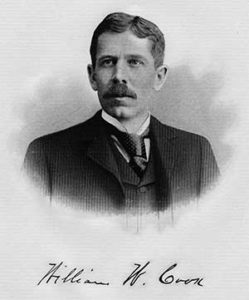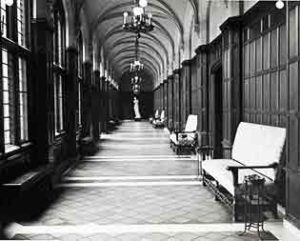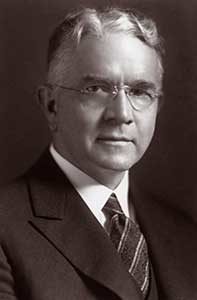Hogwarts rising

The Law Quadrangle takes shape. See a larger version of this image. (Image courtesy of U-M’s Bentley Historical Library.)
Over a span of 10 years in the 1920s and ’30s, the people of Ann Arbor watched as the greatest building project in the city’s history transformed the south side of campus.
Sagging old boarding houses along South University gave way to majestic stone towers, porticos, vaulted arches, bulky buttresses, and stained-glass windows fit for a medieval cathedral. If construction had happened more recently, fans of the Harry Potter series might have imagined the boy wizard’s academy, Hogwarts, had been transported to Michigan.
In reality, it was the new home of the University’s Law School, and it was the gift of a single man, William Wilson Cook, a law graduate of 1882 and an LSA grad of 1880. He was one of the wealthiest lawyers in America.
For years, sitting in his office in Manhattan, Cook managed the building project down to the smallest details. The extraordinary gift represented the culmination of a career devoted to the law. Everything he believed in, he incorporated into the planning of this tribute to his alma mater.
Yet Cook never saw the Law Quadrangle being built, and he died before it was done. Nor did he ever see the Martha Cook Building, named for his mother, the first of his gifts to the University. He refused every invitation to come and inspect the construction sites. He visited his home town of Hillsdale, Mich., just 70 miles away, but not Ann Arbor.
Why not? Why did he never see the realization of his vision and generosity?
A lucrative law career
 According to Margaret Leary, director emerita of the Law Library and author of Giving It All Away: The Story of William W. Cook & His Michigan Law Quadrangle, there were several reasons for Cook to stay away from Ann Arbor.
According to Margaret Leary, director emerita of the Law Library and author of Giving It All Away: The Story of William W. Cook & His Michigan Law Quadrangle, there were several reasons for Cook to stay away from Ann Arbor.
In the early years of his philanthropy — the 1910s, when Cook gave the money for the Martha Cook Building — Leary believes he was simply too busy to leave New York.
As a young man, he had gone to work for John W. Mackay, a tycoon twice over — first in Nevada’s silver mines, then in transoceanic telegraph cables. As general counsel for Mackay’s growing empire, Cook so thoroughly mastered the law of corporations, then a new specialty, that he wrote a massive treatise on the field when he was only five years out of law school.
By the 1910s, Cook was busier than ever with the Mackay Companies’ sprawling affairs. Divorced and childless, he led an active private life divided between his townhouse in Manhattan, a country estate in neighboring Westchester County, and a hunting and fishing club in rural Pennsylvania. There was little time left for jaunts to Ann Arbor.
To save the nation

Cook’s mother, Martha Cook, is the namesake of his first gift, a women’s residence, to the University. (Image courtesy of U-M’s Bentley Historical Library.)
Then, in 1920, Cook became ill. The diagnosis was tuberculosis, and his doctor advised him to restrict his travel.
He pivoted from his law practice to two new pursuits. One was a book, a dense tome titled American Institutions and Their Preservation. It was shot through with Cook’s acerbic views on the state of the nation and the allegedly toxic impacts of essentially every ethnic group but his own tribe of white Anglo-Saxon Protestants.
The other project was to endow and plan a magnificent new facility for the Law School at Michigan.
In Cook’s mind, the two projects — the book and the Law Quadrangle — were related. He believed the profession of law was the nation’s bulwark, the key institution that would save America from the corrosive forces of concentrated wealth, organized labor, and “millions of impossible people from southern and eastern Europe.” So he intended to build up Michigan as the nation’s greatest law school, where the brightest minds would be trained for the good fight ahead.
But almost from the start, Cook’s relations with leaders at Michigan were complicated and troubled. That was another reason, according to Margaret Leary, why he may have dreaded a visit.
The donor and the dean
Cook got along well with U-M President Harry Burns Hutchins, a former dean of the Law School who initiated talks with Cook about a major gift. But Hutchins soon retired. The University’s relationship with the donor in New York fell mostly to Henry Moore Bates, the dean of the Law School.
This was a disastrous match.

Law alumnus Henry Moore Bates, dean of the Law School from 1910-39, clashed with Cook. (Image courtesy of U-M’s Bentley Historical Library.)
Cook was domineering, suspicious, and headstrong, and much the same could be said of Bates. (After one meeting with the dean, Regent James Murfin told the new president, Marion Burton, “Much as I deplore my own disposition, which goodness knows is bad enough, I thank heavens I do not possess his.”) Before long, Cook and Bates loathed each other.
In long letters, Cook would chastise Bates for dithering and bad judgment. He told Bates his professors in the Law School made him think of “the lawyers in my native town when I was a boy. They would hibernate most of the year and sit around and put their feet on the table and tell stories and smoke bad seegars [sic]… What I am trying to do is to wake you people up.” (Many years later, Cook’s niece, Florentine Cook Heath, said: “Most of the disturbing letters he wrote with a twinkle in his eye, but the twinkle didn’t show in Ann Arbor.”)
Fearful of losing Cook’s money, Bates put up with the scolding. But privately he steamed about “Mr. Cook’s little pleasantries…his digs…the abject humility which he seems to like in others…All of his arguments could be easily demolished; but where a man is proposing to give 20 or more millions…all you can do…is to lie down and be rolled over, as gracefully as possible…”
Cook was determined to go slow with funding and construction, taking one building at a time, starting with dormitories. But Bates kept needling him to pledge more money for the buildings he wanted most — a law library and a building for faculty and classrooms.
Finally Cook told a go-between: “I want no further correspondence with Bates.” And if he couldn’t exchange letters with the man, no doubt he could bear even less the thought of listening to Bates make his pitches in person.
When President Burton died suddenly and was replaced by Clarence Little, Cook conceived a dislike for the new president that nearly matched his distaste for Dean Bates — yet another reason to keep clear of his home state.
“A wonderful ornament”

Architectural rendering of the tower of the Lawyers Club. (Image courtesy of U-M’s Bentley Historical Library.)
Time and again, friends in Michigan urged Cook to come and see the construction underway. But he always said no. (A rumor went around that he once snuck back for a surreptitious look, but Leary said there’s no proof of it.)
Turning down an invitation from ex-President Hutchins, the donor wrote: “I feel my head is clearer at this distance, where a fixed purpose is not disturbed by the swirling eddies of University life.”
In 1924, Regent Walter Sawyer, an old Hillsdale friend and a prominent doctor, wrote to tell Cook of the thrill he had felt upon seeing the Lawyers Club under construction at the corner of State and South University.
“It is a magnificent building,” Sawyer wrote, “the most beautiful architecturally that I have ever seen. It is a wonderful ornament to the University…Nothing has ever happened in the history of the University that is so important. I wish you might see it and enjoy it as we do.”
Again Cook said no.
“I shall never go”

Instantly popular, the Law Quad offered these students a place to lounge in 1928. (Image courtesy of U-M’s Bentley Historical Library.)
When Cook visited Hillsdale, he and Sawyer spoke at length about the progress of construction. Sawyer said to his old friend: “Why don’t we get in the car and drive over to Ann Arbor for a look?”
Here Cook gave another sort of demurral, a mysterious hint that something besides practical concerns was keeping him away.
“No, doctor,” he said, “you cannot persuade me. You want to spoil my dream. I shall never go to Ann Arbor.”
The Lawyers Club, the first of the buildings, was completed in 1924. The rest would take nearly 10 more years to complete — the John P. Cook dormitory, named for Cook’s father; the Legal Research Building (commonly known as the Law Library); and finally the building that Dean Bates had yearned for most, Hutchins Hall. The Law Quadrangle as a whole was dedicated in 1934.
But Cook had died in 1930.
In Ann Arbor, there was gratitude for all Cook had done. But no one could claim to have really understood him. Shirley Wheeler Smith, the secretary of the University, who had dealt with Cook often at a distance, concluded later that he was “a strange composite of the urbane and the tyrannical, the generous and the suspicious, the dreamer and the dictator.”
Sources include Margaret Leary, Giving It All Away: The Story of William W. Cook & His Michigan Law Quadrangle (2011); James Tobin, Michigan Law at 150: An Informal History (2009); and Shirley W. Smith, Harry Burns Hutchins and the University of Michigan (1951). For Cook’s fight over the fate of six stone “gargoyles” in the Law Quad’s main archway, see “When Heads Rolled,” The Heritage Project. For the story of Cook’s gift of the women’s residence hall named for his mother, see “Mr. Cook’s Women.”




Donald Parshall - 1976 (Dearborn), 1979 (Law)
This article, while a good summary of the torturous process that led to the building and endowment of the Law School, does not really do the subject justice. I highly recommend Ms. Leary’s book. When I lived in the law quad in the late ’70s there were abundant rumors about Mr. Cook and how the quad came to be. Ms. Leary, who was the librarian while I was at the Law School, tells the tale based on meticulous research and with I think an excellent understanding -and some sympathy towards-the people involved and the times in which they lived.
Reply
Rob Saltzstein - 1968 and 1971
A touch of Princeton, a touch of of Duke, a touch of Oxford and a touch of Cambridge: the Michigan Law Quadrangle Library was always my favorite place to study as an undergraduate. I always felt echoes of greatness there and the promise of great things to come. I knew that the person sitting next to me might perhaps become a famous heart surgeon or a Supreme Court justice or best selling author. It was exhilarating to study in that environment and to feel a part of it.
I used the law library as a sanctuary for concentration. There were no interruptions there save for the the shuffling of feet and chairs from time to time as students and visitors came and went. I found that I could write essays, history papers, Michigan Daily articles and the like much more effectively in the law library than anywhere else on campus.I am not sure why but perhaps the sheer beauty of the place with its stained glass windows and gorgeous lighting just brought out the best in me. Retired now and living in Florida, whenever I am in Ann Arbor, I make it a point to visit the library and the quadrangle. I always had a feeling that the heart and soul of the University of Michigan lived in that library and the article on Mr. Cook’s generosity in funding it brought back that feeling. I am sorry he didn’t see it but I know he knew he was doing something good of impossible -to- calculate value with his wealth that would inspire for generations to come.
Reply
Chris Campbell - 1972(MA); 1975 (JD)
As a student with a bias against great wealth, I always made an exception in my mind for Mr. Cook. I would sit in the library and understand the positive uses that could be made of accumulated money, illustrated by the grandeur around me. Public universities generally can’t be quite as extravagant in their building projects, but when a wealthy donor directs it, we get a result like the Law Quad. Perhaps I would have learned just as effectively in a lesser facility. The experience would not have been a rich and memorable, however. The quality of our environment does matter.
Another lesson from the article is that anti-immigrant biases always look foolish a generation later when the immigrant groups have demonstrated their industry, vitality, and contributions to our culture. The groups whose presence he lamented have long since done that and newer groups continue to do so.
Chris Campbell
Reply
Chris Campbell - 1972 (MA); 1975 (JD)
Another comment. U-M is so lucky to have James Tobin doing his historical pieces. They are uniformly superb. From time to time I reread “Professor White’s Diag,” a moving story about our university and an important person. Anything with Mr. Tobin’s name affixed deserves attention.
Chris Campbell
Reply
Dave Burhenn - 1975, 1982 (JD)
We are indeed fortunate to have my old Daily colleague, Dr. James Tobin (I knew him when he was just plain Jim), excavating the past. The Law Quad is a treasure — when an expansion of the library was required in the 1970s, the University went to Gunnar Birkerts, a noted Detroit-area architect and U-M faculty member, for the design. Allegedly there was so much irritation at the resulting modernist pile that Birkerts went back to the drawing board and produced a brilliant solution — the underground addition now named for Dean Allen and Alene Smith. Now, nothing competes with the original York and Sawyer Jacobean and Gothic buildings given to the University by the eccentric Mr. William W. Cook.
Reply
Donald Parshall - 1976 (Dearborn) 1979 (Law)
I wanted to drop a “footnote” re: Mr. Tobin (can you tell I am a lawyer?) and share an anecdote about the underground addition to the Law library. I read Mr. Tobin’s book about President Roosevelt’s political career post polio. It brought to mind a debate in an undergraduate political science course re: whether George Wallace’s confinement to a wheel chair should “disqualify” him from being President. Having known of President Roosevelt’s polio I pointed out that whatever else might be said for or against Mr. Wallace he was “capable” of serving as President. I was surprised that most of my classmates were unaware of President Roosevelt’s having had polio. Kudos to Mr. Tobin for an excellent treatment of that topic.
As to the library addition, the hole was dug during my second year of law school with much attendant disruption to my ability to study in my dorm room. One of the other dorm residents actually went to the then Dean and suggested that the covenant of quiet enjoyment in his dorm room lease was being breached by the construction. This apparently resulted in a “settlement” with a confidentially provision that other residents not be told about the refund. The complaining resident ultimately became Dean of the Law School himself…
Reply
James Tobin
Dave…thanks for the kind words, and please stay tuned for a piece coming soon on the Birkerts/Smith addition, which will be on the Heritage Project site: https://heritage.umich.edu/ …. Jim
Reply
Bob Merchant - 1968
When discussing memorable architecture, it seems at least appropriate to mention the architect or architects that actually designed the project. Money to finance it one big part, but it also takes the skill and creativity of an artist to see the dream completed.
Reply
Karen Manders - BA ‘83; JD ‘86
Just had to second the comment about James Tobin. I always look forward to his pieces and had the good fortune to have Mr Tobin as a TA in legendary Professor Sidney Fine’s US history courses. The Law Quad is truly a gem…right along with Professor Fine and Jim Tobin!
Reply
holdship
Good point. Please forgive the oversight. Cook chose, for the Law School project, the firm of Edward York and Philip Sawyer, who had designed and built a townhouse for Cook at 14 East 71st Street, next to the Frick Museum Library, half a block from Fifth Avenue and Central Park. In both projects, Cook and his architects incorporated work by artisans such as Samuel Yellin (metal work) and Rafael Guastavino (tiled arches).
Source: http://www.law.umich.edu/historyandtraditions/buildings/Pages/Gifts-to-the-Law-School.aspx
Reply
Bruce Frier
For those who are interested in the architecture of the law quadrangle, by far the best book on the subject is Ilene Forsyth’s The Uses of Art: Medieval Metaphor in the Michigan Law Quadrangle. It was published in 1994 and is now out of print, but remains easily available through Amazon.com’s used book market. Forsyth captures most of what is really important about the law quad’s architecture, including its relationship to earlier Collegiate Gothic buildings in the USA and the qualities that distinguish it from them.
Reply